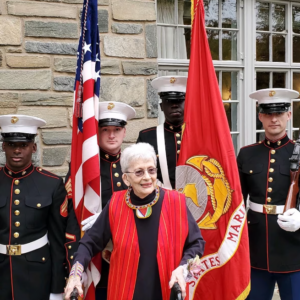She Wasn’t Allowed in Combat, So They Had Her Train the Fighter Pilots
Originally published by Petula Dvorak for the Washington Post
When Betty Printz Sims was exacting with her family — which wasn’t too often, because she was mostly a jovial and gentle mother — they figured she was simply bringing her music teacher persona home.
“I was maybe in my 30s when I found out she was a Marine. In my 50s when I understood what she did,” said her younger daughter, Rebekah Sims, who finally had the explanation for her mother’s need for precision in the annual family Christmas carol singalong.
Printzy, as she preferred to be called, wasn’t just a Marine, but also a fixed gunnery instructor. She wasn’t allowed incombat under the old rules, so instead she taught World War II fighters how to shoot like her.
“These pilots were highly incensed,” Printzy said, in an interview stored in the Library of Congress archives. “Number one, they had to have training, because some of them had come back from Solomon Islands and Guadalcanal and shot by the seat of their pants. And number two, to have women to train them. That was highly insulting to them.”
Printzy was believed to be the United States’ oldest female Marine veteran until last week, when she died in her sleep at age 104 in D.C.
In 1941, Printzy was a graduate of Grinnell College and a music teacher in a small German town in Iowa. Her life changed on Dec. 7 when she was huddling under the covers in her bed because “our landlady was so cheap she wouldn’t turn the heat up,” listening to the New York Philharmonic on the radio. The broadcast was interrupted announcing the bombing of Pearl Harbor.
“And I thought, where is Pearl Harbor?” she said.
“All I knew was I didn’t want to continue teaching music in a little town in Iowa,” she said. “I want to do something constructive for the war effort.”
She unsuccessfully tried to join the Red Cross. So she went to Des Moines and visited all the recruiting stations, trying to find a way to help.
Sims said this was the moxie that defined her mother’s life. While most women joined the war effort by planting victory gardens or riveting in factories, her mom — proud that one of her ancestors had been part of the colonial Marine force — was determined to become a Marine.
She kept asking her mom, “Why the Marines?” But beyond the family history, it seemed it was simply the spirit of adventure in Printzy, something supported by her parents, who encouraged a free-range childhood in the 1920s.
She arrived at Camp Lejeune for “six whole weeks” of basic training, up at dawn, drilling, marching. She wanted to be a control tower operator, but her application to the aviation division diverted her to the fixed gunnery department.
She was trained to shoot like a fighter pilot and became a trainer, sitting in front of pilots in a simulator on the base, holding the stick and projecting images of a German Focke-Wulf or a Japanese Betty on the screen in front of them, drilling their reflexes.
“In operating a stick, it was difficult to wear skirts,” she said. “We went to the quartermaster to ask for male pants.” So the three female gunnery trainers had to carry around the letters proving they were allowed to wear pants because they were turned away from the mess hall when they showed up and weren’t in skirts.
